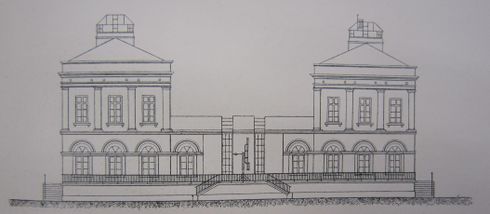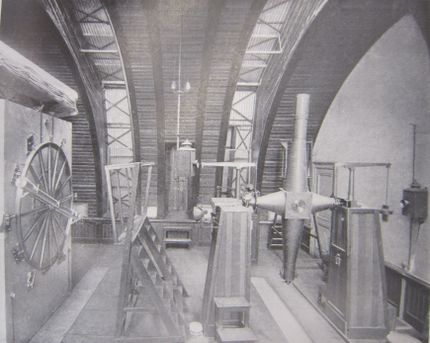Royal Observatory of Belgium
Ga naar list of people connected to the Royal Observatory
More on the building of the former Brussels Observatory
| 1891- | Observatoire royal de Belgique – Koninklijke sterrenwacht van België |
| 1839-1891 | Observatoire royal de Bruxelles - Koninklijke sterrenwacht van Brussel |
| 1823-1839 | Observatoire de Bruxelles - Sterrenwacht van Brussel |
Contents
[hide]History
From 1823, during the reign of William I, Adolphe Quetelet urged the then minister of public education Anton-Reinhard Falck to build an observatory in Brussels. His proposal was well-received with much enthousiasm by the Dutch government. An official fiat for the project follows with the royal decree of 8 June 1826. Six months later, in early 1827, work started on a new building at the Schaarbeek gate, in Sint Joost-ten-Node. Already during construction, the first meteorological observations are started. Astronomical research lags behind, due to a lack of equipment and measuring instruments.
Quetelet was appointed director on 9 January 1828 and took office on 1 April the same year. However, construction work is delayed, and during the revolutionary uprising of 1830, work is halted altogether.
[1]
On 8 December 1830, the provisional regime confirmed Quetelet as director. In 1832, scientific activities are resumed. Meteorological observations can also be resumed in 1833, and in 1841 the institute begins the study of magnetism. Actinometric research starts the following year. Quetelet also starts building a library for the institute. Subsequent directors will all contribute to the expansion of the collection. The library currently contains more than 10,000 works. The year 1834 marks the end of the construction work and the installation of the necessary observatory equipment.
[2]
In 1839 Leopold I grants the institute the title of "Royal Observatory of Brussels". The first meteorological bulletin is produced in 1876. It is based on the analysis of synoptic maps. The first Belgian astronomical expedition is organised by director Jean-Charles Houzeau in 1882. The first star catalogue published by the institute appears in 1887. It contains 10,792 descriptions of stars, based on observations between 1857 and 1878.
The years 1890-1891 mark the Observatory's move to Uccle, where construction of a brand new institute had already begun in 1883. On this occasion, the Royal Observatory of Brussels was renamed the "Royal Belgian Observatory". Major reforms take place in 1897, with a view to separating the astronomy service from the meteorology service. Although both services remain within the same institution, from 1898 meteorology is run as an independent service by Albert Lancaster, while the astronomy service continues its activities under the direction of Georges Lecointe. [3] In 1901, the continuous recording of seismological tremors from Belgian soil starts. In 1904, a seismology service is established under Lecointe. On 31 July 1913, the two Observatory services are definitively split as a result of the creation of an autonomous institution, the Royal Meteorological Institute (RMI). Jean Vincent becomes its first director. Paul Stroobant, meanwhile, starts an astrophysics service under the Observatory roof. On 25 November 1964, the aeronomy service of the RMI also becomes an independent institute. The first director of this Royal Belgian Institute for Space Aeronomy is Marcel Nicolet. The Royal Decree of 21 April 1965 divides the activities of the Observatory into four departments: positional astronomy and geodynamics, astronomy and celestial mechanics, astrophysics, radio astronomy and solar physics.
Directors
| 1823-1874 | Ad. Quetelet |
| 1876-1883 | Jean-Charles Houzeau de Lehaie |
| 1885-1897 | François Folie |
| 1900-1923 | Georges Lecointe |
| 1925-1936 | Paul Stroobant |
| 1936-1947 | Eugène Delporte |
| 1947-1963 | Paul Bourgeois |
| 1963-1983 | Albert Velghe |
| 1981-1990 | Paul Melchior |
| 1991-2002 | Paul Pâquet |
| 2002-2005 | Roland Verbeiren |
| actuellement | Ronald Van der Linden |
Publications
- Annuaire de l'Observatoire royal de Belgique.
- Annales de l'Observatoire royal de Bruxelles gevolgd door Annales de l'Observatoire royal de Belgique
- Vanaf 1880: Ciel et terre which fuses with the Bulletin de la Société belge d'astronomie, de météorologie, et de physique du globe in 1909. [4]
Bibliography
- DE ROY, Félix, "Le Centenaire de l'Observatoire royal de Belgique", in Gazette Astronomique, d. 13, 1926, p.29-32.
- KOECKELENBERGH, André, "l'Astronomie et le géophysique externe", in Robert Halleux, Geert Vanpaemel, Jan Vandersmissen en Andrée Despy-Meyer (red.), Geschiedenis van de wetenschappen in België 1815-2000, Brussel: Dexia/La Renaissance du livre, 2001, vol. 1 p. 145
- "Le Centaire de l'Observatoire royal de Belgique 1835-1935", in Gazette Astronomique, d. 13, 1935, p.37-48.
- "Observatoire royal de Belgique.", in Wikipédia, l'encyclopédie libre, consulté le 16/02/2012 à 13h10.
- Website van de Koninklijke Sterrenwacht, geraadpleegd op 16/02/2012 om 13u00.
- Le mouvement scientifique en Belgique 1830-1905, volume 1, Luik, 1907.
Notes
- Jump up ↑ Website of the Koninklijke Sterrenwacht, consulted on 16/02/2012 at 13h00.
See also: The history of the observatory on their website (in dutch). - Jump up ↑ Website of the Koninklijke Sterrenwacht, consulted on 16/02/2012 at 13h00.
- Jump up ↑ KOECKELENBERGH, André, "l'Astronomie et le géophysique externe", in Robert Halleux, Geert Vanpaemel, Jan Vandersmissen en Andrée Despy-Meyer (red.), Geschiedenis van de wetenschappen in België 1815-2000, Brussel: Dexia/La Renaissance du livre, 2001, vol. 1 p. 145.
- Jump up ↑ KOECKELENBERGH, André, "l'Astronomie et le géophysique externe", in Robert Halleux, Geert Vanpaemel, Jan Vandersmissen en Andrée Despy-Meyer (red.), Geschiedenis van de wetenschappen in België 1815-2000, Brussel: Dexia/La Renaissance du livre, 2001, vol. 1 p. 145.

